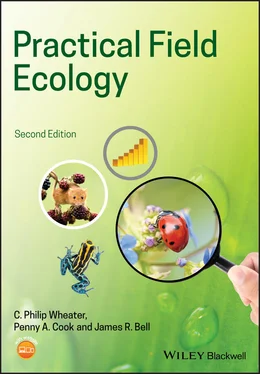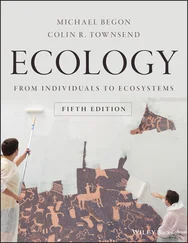Preface to the First Edition
This handbook is designed as a guide to planning and executing an ecological research project and is intended as a companion to preparing a dissertation, report, thesis, or research paper. The idea for the book arose from many years spent in the field sampling animals and plants, as students ourselves, or later when leading groups of undergraduate or postgraduate students. In so doing, it was clear that there was a need for a book to cover all aspects of planning, implementing, and presenting an ecological research project. Much of the content of this text has been developed from teaching materials we have used over the years in one form or another, refined following discussions with colleagues and the students who used them. We have included those methods that should be accessible to an undergraduate or taught postgraduate student at a university or college. We have purposely tended to avoid devoting too much space to highly technical methods or those techniques that require the user to have a licence. However, we have mentioned some such techniques that generate data sets that may be made available for student projects.
Our experience is that many students develop an interest in a particular group of organisms, sometimes describing themselves as a birder, entomologist, or badger watcher. Rarely, one finds a student principally interested in a particular habitat; this is normally secondary and is often defined by the group under study. Consequently, although we have ordered the sampling chapters by the mobility of the organisms, within the chapter on sampling mobile animals, we have dealt separately with each group of organism under study. We have attempted to take the reader through all the stages in conducting a research project starting from finding a topic on which to do a research project; turning the idea into a provisional title and research question (i.e. the aims); thinking about how to achieve the aims (these are the objectives); and then deciding on the methods to be used. The book then summarises key methodological approaches used by ecologists in the field. The intention has been to cover core, well‐tested, and robust methods relevant to sampling animals and plants in terrestrial and most aquatic habitats, including sandy and rocky shores. Due to additional health and safety requirements and the highly technical nature of off‐shore sampling methods, we stopped short of including these techniques in the book.
This book is not just about the activities associated with field sampling. We felt that it was important to take researchers right through to the end of their project. Many of the more technical hurdles occur once the data has been collected. Ecological research frequently generates complex data sets that require statistical analysis to aid interpretation. There is a need for students to understand the range of methods available to explore and analyse their data and to understand what types of data they need to collect in order to use particular techniques. Frequently, students ask us how they should go about finding and using key references, and how to interpret their own data in the light of current research. Consequently, we also give tips on presentation and writing style. Most research projects are completed in a fairly restricted timescale, therefore we include guidelines for time management during the project. We hope that this text will both encourage and support students in engaging in the fascinating world of ecological research.
It would be difficult to find any field biologist who had enough experience to write about sampling animals and plants without contributions from fellow ecologists. We would like to thank all those who were generous with both their time and expertise:
1 Amanda Arnold (Queen Mary's University, London) advised on aquatic invertebrates;
2 Joanna Bagniewska, Sandra Baker, Hannah Dugdale, and Stephen Ellwood (WildCRU, University of Oxford) gave advice on survey techniques for mammals;
3 Katherine Boughey and the Bat Conservation Trust gave advice on monitoring bats;
4 Philip Briggs (Bat Conservation Trust) provided helpful discussions on bats;
5 Mary Brierley, David Groom, and Sue Hutchinson (Manchester Metropolitan University – MMU) helped with technical details and supplied equipment for many of the images;
6 Dave Brooks (Rothamsted Research) provided material on CCA;
7 Paul Chipman (MMU) contributed to mammal sampling and statistics;
8 Suzanne Clark, John Cussans and Sue Welham (Rothamsted Research) advised on mixed effects models;
9 Rod Cullen (MMU) discussed sampling invertebrates;
10 Cathy Delaney (MMU) advised on soil sampling;
11 Mike Dobson (Freshwater Biological Association) advised on aquatic invertebrates;
12 Mark Elgar (University of Melbourne) commented on the proposal for the book;
13 Alan Fielding (MMU) advised on Chapter 5;
14 Chris Goldspink (MMU) advised on fish sampling;
15 Mark Grantham, David Leech, Rob Robinson (BTO) supplied information on birds;
16 Ed Harris (MMU) advised on sampling amphibians and reptiles;
17 Paul Hart (Leicester University) supplied information on electrofishing;
18 Øyvind Hammer (Paleontological Museum, University of Oslo) discussed applications within the PAST software package;
19 Martin Hartup (Burnham Beeches) provided information on, and practical experience of, reptile sampling;
20 Alison Haughton (Rothamsted Research) provided internet information, alerted us to the less obvious information sources, and contributed to Chapter 6;
21 Mike Hounsome (University of Manchester) advised on bird sampling and statistics;
22 Martin Jones and Stuart Marsden (MMU) advised on bird sampling;
23 Jonathan Lageard (MMU) advised on tree coring;
24 Mark Langan (MMU) commented on Chapter 1and provided information on aquatic invertebrate sampling and statistics;
25 Les May (MMU) provided guidelines on field notebooks and advised on sampling using animal sounds;
26 Jacqui Morrison (MMU) advised on camera trapping;
27 Ed Mountford (JNCC) contributed towards the forest techniques section, especially mensuration;
28 Richard Preziosi (University of Manchester/MMU) commented on the proposal for the book and discussed various sampling and statistical methods;
29 Liz Price (MMU) helped with plant sampling;
30 Helen Read (Burnham Beeches) advised on Chapters 1– 3;
31 Ian Rotherham (Sheffield Hallam University) commented on the proposal for the book;
32 Robin Sen (MMU) advised on microbial techniques;
33 Emma Shaw (MMU) advised on sampling and monitoring spiders;
34 Rob Sheldon (RSPB) was helpful when preparing the bird section;
35 Dave Shuker (University of Edinburgh) commented on the proposal for the book;
36 Richard Small and David Wilkinson (Liverpool John Moores University) commented on the proposal for the book and on Chapters 1– 3;
37 Graham Smith (MMU) advised on GIS and remote sensing;
38 Nigel Stork (University of Melbourne) provided information on fogging;
39 Rob Strachan (Environment Agency for Wales) gave insights into less well‐known survey techniques for mammals;
40 Michelle Tobin (University of Hull) commented on the proposal for the book;
41 Derek Yalden (University of Manchester) advised on mammal sampling.
Our appreciation to all those who wrote case studies:
1 Henry Andrews, Katharine Clayton, Oliver Haines, and Thomas Hamilton Koch (Bat Tree Habitat Key Project – BTHKP) and Steaphan Hazell (NHBS) – bat tree‐roost net;
2 Karen Anderson (University of Exeter) – lightweight drones;
3 Amanda Arnold (Queen Mary University of London) – aquatic invertebrates;
Читать дальше












